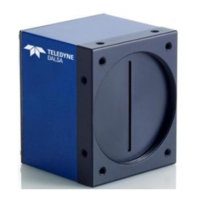50 Spyder3 S3-14 and S3-24 Monochrome Camera User's Manual
03-032-20117-01 Teledyne DALSA
Camera Link Command
i
Calibration algorithm to use.
1 = This algorithm adjusts analog gain so
that 8% to 13% of tap region of interest
(ROI) pixels are above the specified target
value.
2 = This algorithm adjusts analog gain so
that the average p ixel value in tap ’s ROI is
equal to the specified target value.
3 = This algorithm adjusts digital gain so
that the average p ixel value in tap ’s ROI is
equal to the specified target.
4 = This algorithm adjusts the analog gain
so that the peak tap ROI pixels are adjusted
to the specified target.
t
Tap value. Use 0 for all taps or 1 to 2 for
individual tap selection if you are using the
two tap model.
i
Calculation target value in a range from
1024 to 4055DN (12 bit LSB).
This function requires constant light input while
executing.
If very few tap pixels are within the ROI, gain
calculation may not be optimal.
When all taps are selected, taps outside of the
ROI are set to the average gain of the taps that
are within the ROI.
Perform analog gain algorithms before
performing FPN and PRNU calibration.
All digital settings affect the analog gain
calibration. If you do not want the digital
processing to have any effect on the camera gain
calibration, then turn off all digital settings by
sending the commands: sdo 0 0, epc 0 0,
ssb 0 0, and ssg 0 4096
Setting Analog Offset
Sets the analog offset. The analog offset should be set so that it is at least 3 times the rms noise value at
the current gain. Teledyne DALSA configures the analog offset for the noise at the maximum specified
gain and as a result you should not need to adjust the analog offset.
Camera Link Command
t
Tap selection. Use 0 for all taps or 1 to
2 for individual tap selection if you are
using the two tap model.
i
Offset value in a range from 0 to
255DN (12 bit LSB).
To return the current analog offset value, use
the command gcp or get sao.

